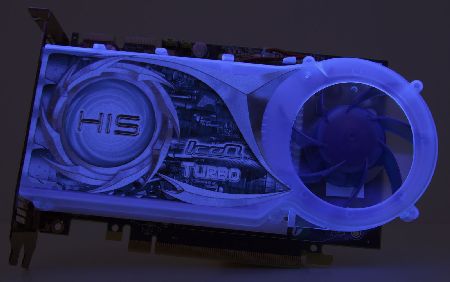6 Graphics Cards with Luxury Trimmings
HIS Radeon HD 2600 XT IceQ Turbo
The IceQ cooler is very quiet, at 38.8 dB(A).
The fan and cooler case both react to UV light.
HIS's IceQ version of the Radeon HD 2600 XT is much quieter and runs at higher clock speeds than the standard models. The large IceQ heatsink/fan combination ensures low temperatures and even lower noise levels; this leads to a certain amount of overclocking headroom, as indicated by the "Turbo" moniker. HIS advertises the card as being clocked at 830 MHz (GPU) and 1860 MHz (memory; physical clock speed is 930 MHz).
While you could probably overclock the Zalman version of this card to similar levels, the IceQ version offers two advantages. First, you don't risk voiding your warranty due to overclocking; second, you get to enjoy performance that is independent of the driver and needs no additional tweaking. In 2D mode, the card's temperature reaches 50°C, while in 3D mode it climbs to 66°C.
There is only a $9 price difference between the Zalman and IceQ versions of the His Radeon HD 2600 XT. Thanks to the better stock performance of the IceQ Turbo version, both offer virtually identical value for your money. In the end, we think that the Zalman version is only really interesting if you are limited to a single-slot cooling solution. If you have the space for a dual-slot cooler, we recommend choosing the faster IceQ Turbo card.
The HDMI logo is misleading, since the card doesn't come with an appropriate adapter.
The card's equipment consists of only an HDTV component cable and a video cable.
Get Tom's Hardware's best news and in-depth reviews, straight to your inbox.
The backplane features two DVI ports and a video connector.
The IceQ cooler makes the card a dual-slot solution.
Current page: HIS Radeon HD 2600 XT IceQ Turbo
Prev Page HIS Radeon HD 2600 XT Zalman Next Page MSI Geforce 8600 GTS Diamond Plus




